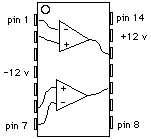
Chemistry 498A Laboratory, Fall 1996
2. The first objective is to try to find an equation that will allow the temperature to be calculated from the measured resistance. Note the temperature-resistance table on the back of the package (which saves you a laborious calibration job). Type the data between 0 °C and 40 °C into MacCurveFit (a shareware curve-fitting application that is available on the computers in the lab) and try to find an equation that fits the data well in this region. Note: since the objective is to calculate the temperature from the measured resistance, which variable (temperature or resistance) should be on the x-axis and which on the y-axis before you do the fit? Does it matter? Why or why not?
Try different fitting equations, such as linear, polynomial, exponential, etc. Can you find a good fit? Once you find your best fit, test your equation by converting a few resistances into temperatures and compare to the calibration chart. If you used your equation to convert resistances to temperature, rather than the calibration table, how far off would your temperature measurements be (assuming that the calibration table is perfectly accurate)?
3. Direct-reading electronic thermometer. Solving a fancy equation is OK if you have a computer at your disposal, but suppose you want a simple direct-reading thermometer, for use in the 0 to 40 °C range, that reads out the temperature directly as a voltage. One way to do this, which works fairly well over a limited temper ature range, is to make a voltage divider with the thermistor as R1 and a 10K resistor as R2. If you apply a constant voltage to the input of the voltage divider, the output voltage (across the 10K resistor) will be approximately proportional to temperature. Construct this circuit and test it at a few temperatures, using ice and hot tap water as needed.
4. Now devise a way to display the output signal of your temperature-sensitive voltage divider on the 100 °A panel meter such that the current in °A equals the temperature in °C (from 0 °C and 40 °C). To do this, you may use one or more operational amplifiers to supply any needed gain (or adder circuits to supply any needed offset voltage). This will require some trial-and-error experimentation. You may also use the resistance decade boxes and/or the 20K Helipots for continuously variable resistances (which could be replaced ultimately with fixed resistor combinations). Test it at a few temperatures and produce a table of measured vs actual temperature.
